List of former mosques in Portugal
This is a list of former mosques in Portugal. It lists some but by no means all of the former mosques of Portugal. It lists former Muslim mosques (Portuguese: Mezquita Arabic: Masjid) and Islamic places of worship in Portugal.
The term former mosque in this list includes any mosque (building) or site used for Islamic Prayer (Salah) in Portugal but is not so any longer.
Most of the former Portuguese mosques were built and used as Muslim places of worship during the Al-Andalus era when several Muslim Moorish kingdoms and empires ruled large parts of the Iberian Peninsula including most of modern Portugal. Many former mosques and Islamic religious buildings were either converted into churches or demolished after the Christian Reconquista of the Iberian Peninsula.[1] However, this list does not include the former mosques in Spain that were built during Al-andalus period.
Mosques were important buildings during Arab Moor rule in Portugal. They formed an important part of Moorish architecture. Portuguese mosques and religious buildings had a square plan layout. Minaret towers were normally built in a corner of the mosque. They were used for announcing the Islamic prayer call known as Adhan, five times a day. The qibla or direction the faithful should face when performing Islamic prayers (Salah) was indicated by a small niche called mihrab on the main wall. The mihrab and minaret usually projected out from the main walls of the mosque.[2]
In some mosques like the former Great mosque of Silves, water tanks or cisterns were built to store and supply water for Wudu, the washing ritual performed before prayers.[3] Horseshoe arches were a distinctive Iberian Moor architectural feature. They were commonly used to frame doorways, windows or just as decoration in Portuguese mosques. Four horseshoe doorways remain that opened into a inner courtyard or Sahn remain in Mertola mosque.[4] Mihrabs, horseshoe arches and door frames were decorated with detailed patterns formed by intertwining lines, known as arabesque. They had patterns of geometric and floral motifs. Simple shapes, repeated in symmetrical arrays giving a beautiful artistic finish.[2] Unfortunately unlike neighboring Spain only a few of these original mosques and religious structures are still standing.[2]
List of former mosques in Portugal
Note: Mesquita means mosque in the Portuguese language.
| Location | Images | Current Name | Mosque Name | Open Years | Notes | Ref. |
|---|---|---|---|---|---|---|
| Mértola | 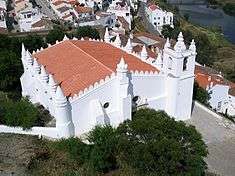 |
Church of Nossa Senhora da Anunciação | Aljama mosque of Martulah | Until late 12th century. | Best preserved former mosque in Portugal, a mixture of Almohad and Manueline architecture. Mosque last rebuilt in second half of 12th century but some elements date to 9th century. In 1532 church modified the mosque building reducing its size from 6 sections & 20 columns to 4 sections & 12 columns. | [5][6] |
| Idanha-a-Velha |  |
Cathedral of Idanha-a-Velha | 9th century to reconquita | Located in a complex, this building functioned as a mosque from 9th century. Its built in Christian style with clear Islamic elements. Enigma remains whether it was built by Muslims (Umayyads or Ibn Marwan) or earlier Visigoths. [7][8] | [7][8] | |
| Loulé | .jpg) |
Church of São Clemente (Loulé), Minaret of Loule | Only minaret of a former mosque exists, used as church bell tower. Its 22.7 metres tall and 4.2 metres across. Church was built in 13th century and is the oldest in Loulé. Across it lies old Arab cemetery of Jardim dos Amuados. Square plan and misalignment in orientation of Church building also indicate presence of a former mosque.[9][10] | [9] [10] | ||
| Beja |  |
Igreja de Santa Maria (Beja) | Church consecrate in 1259 but believe to be a converted old mosque built over a Visigoth temple. Misalignment in orientation, Santa Maria name, and abnormal and unclear profusion of volumes are indicative of mosque origins. Its located among large area of old buildings.[11] | [11] | ||
| Albufeira | Igreja Matriz (Albueira) | Igreja Matriz, main church of Albufeira is a former mosque site. Mosque building survived as converted church until 1755, when it was destroyed by earthquake. Some believe bell tower is a old Muslim tower (minaret) integrated into the rebuilt church.[12] | [12] | |||
| Lisbon | 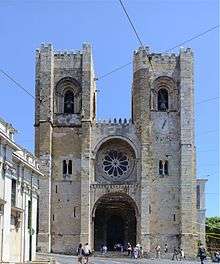 |
Lisbon Cathedral | Lisbon was under Arab Moor rule from 8th to 12th century. It was reconquered in 1147 and new cathedral was built on the site of the main mosque of Lisbon. Partially excavated old cloisters at the rear have revealed structures of former Roman & Visigoth buildings and a very visible part of a Moorish building with red walls probably part of the former mosque.[13][14][15] | [13][15] | ||
| Santarem | Igreja de Santa Maria de Marvila | Church rebuilt and modified several times after founding on an old mosque in the Islamic Medina of Santarém (8th century to 1147).[16] | [16] | |||
| Silves | 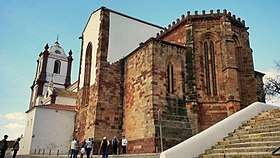 |
Silves Cathedral | Great Mosque of Silves | Located on the site of the old Great Mosque of Silves. Cathedral rebuilt and modified starting from 1268. Silts at the base of the old bell tower are only indication of possible prior mosque remains.[17] 8-9th century Islamic cistern well in Castle street (Silves) is believed to have supplied water to the Great Mosque.[3] | [17] | |
| Tavira | 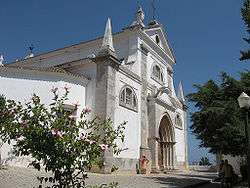 |
Igreja de Santa Maria do Castelo (Tavira) | Mosque stood at the highest point within the fortified Medina of Tavira on the location where Church of Santa Maria stands. Recent excavations unearthed rubbish heaps with 11-12th century materials and dwellings from first half of 12th century.[18] A slight canonical disorientation of the church is indicative of to having used the basic structure of the mosque. In 1718, a tomb was found with a corpse accompanied with a Moorish Alfange blade.[19][20] | [18][19] [20] | ||
| Óbidos | 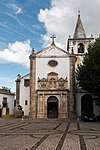 |
Iglesia de Santa María (Óbidos) | Obidos was a old village settlement from Roman times. When Moors captured it they used the Visigoth church as a mosque. In 1148, Obidos was reconquired and a new church was rebuilt later. Nothing remains of the mosque or the rebuilt church as it was completely renovated in 16th century.[21] | [21] | ||
| Faro |  |
Sé Catedral de Faro | Faro was under Arab rule from 8th century for 500 years. According tradition a paleo-Christion basilica on this premises had been converted into a mosque during this era. It was reconverted into a Cathedral when D. Afonso III conquered the city in 1249.[22] | [22] | ||
| Serpa |  |
Igreja de Santa Maria (Serpa) | Church believed built over a mosque site. Remaining indications are bell tower built apart from church body and remains of a cylindrical base.[23] Therefore its believed bell tower was once a minaret.[24] Also Santa Maria was a name usually given to converted mosques. | [23] | ||
| Aljezur |  |
Castle Arrifana ruins | Archaeological site (CNS no. 6924) is interpreted as an Islamic fortress convent warrior monks (murābitūn), founded by Ibn Qasi , in about 1130. It is a rare collection of archaeological structures with only one other being known in Iberian Peninsula. Remains of 8 mosques, a Islamic madrassa college, minaret and other buildings have been excavated to date.[25][26] | [25][26] | ||
See also
References
- ↑ "5 Most Impressive Historic Mosques in Spain". historylists.org. Retrieved 27 September 2018.
- 1 2 3 "Moorish Architecture in Portugal". study.com. Retrieved 4 October 2018.
- 1 2 3 "Islamic Cistern of Castle Street". patrimoniocultural.gov.pt. Retrieved 1 October 2018.
- ↑ "Mértola Mosque". islamicart.museumwnf.org. Retrieved 4 October 2018.
- ↑ "Mertola Mosque". discoverislamicart.org. Retrieved 30 September 2018.
- ↑ "Igreja matriz de Mértola". patrimoniocultural.gov.pt. Retrieved 1 October 2018.
- 1 2 "Mosque Cathedral of Idanha-a-Velha". discoverislamicart.org. Retrieved 1 October 2018.
- 1 2 "A chamada "Catedral" e a velha ponte a este, sobre o Ponsul -". patrimoniocultural.gov.pt. Retrieved 1 October 2018.
- 1 2 "Loule Portugal". algarvetips.com. Retrieved 1 October 2018.
- 1 2 "Minaret of Loule". discoverislamicart.org. Retrieved 1 October 2018.
- 1 2 "Church of Santa Maria da Feira". patrimoniocultural.gov.pt. Retrieved 1 October 2018.
- 1 2 "Igreja Matriz". erasmusu.com. Retrieved 1 October 2018.
- 1 2 "Archaeological excavations in Lisbon's Cathedral Cloister, Portugal". citygomaps.blogspot.com. Retrieved 2 October 2018.
- ↑ "Se Cathedral, Lisbon". lisbonlisboaportugal.com. Retrieved 2 October 2018.
- 1 2 "Sé de Lisboa". patrimoniocultural.gov.pt. Retrieved 2 October 2018.
- 1 2 "Igreja de Santa Maria de Marvila". patrimoniocultural.gov.pt. Retrieved 1 October 2018.
- 1 2 "Sé Catedral de Silves". patrimoniocultural.gov.pt. Retrieved 1 October 2018.
- 1 2 "Castle and Mosque of Tavira". islamicart.museumwnf.org. Retrieved 3 October 2018.
- 1 2 "Trechos românicos da igreja de Santa Maria do Castelo". patrimoniocultural.gov.pt. Retrieved 2 October 2018.
- 1 2 "Parish Church of Santa Maria (Tavira)". patrimoniocultural.gov.pt. Retrieved 2 October 2018.
- 1 2 "Church of Santa Maria de Óbidos". patrimoniocultural.gov.pt. Retrieved 2 October 2018.
- 1 2 "Cathedral of Faro". patrimoniocultural.gov.pt. Retrieved 2 October 2018.
- 1 2 "Igreja de Santa Maria, matriz de Serpa". visitportugal.com. Retrieved 3 October 2018.
- ↑ "Photos of Serpa Town". islamichistoryandtravel.com. Retrieved 3 October 2018.
- 1 2 "Ribāt da Arrifana". vale-da-telha.eu. Retrieved 2 October 2018.
- 1 2 "Ribat da Arrifana". patrimoniocultural.gov.pt. Retrieved 2 October 2018.